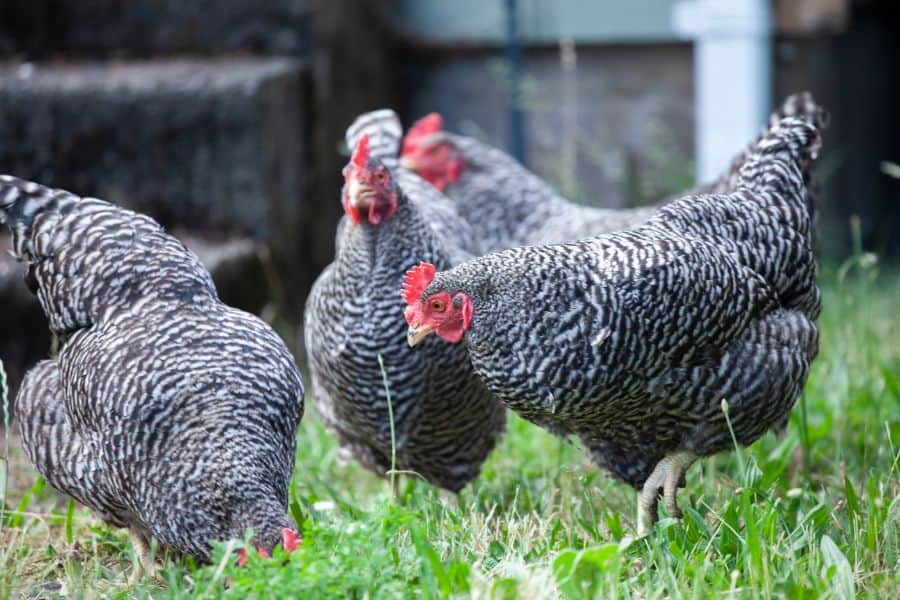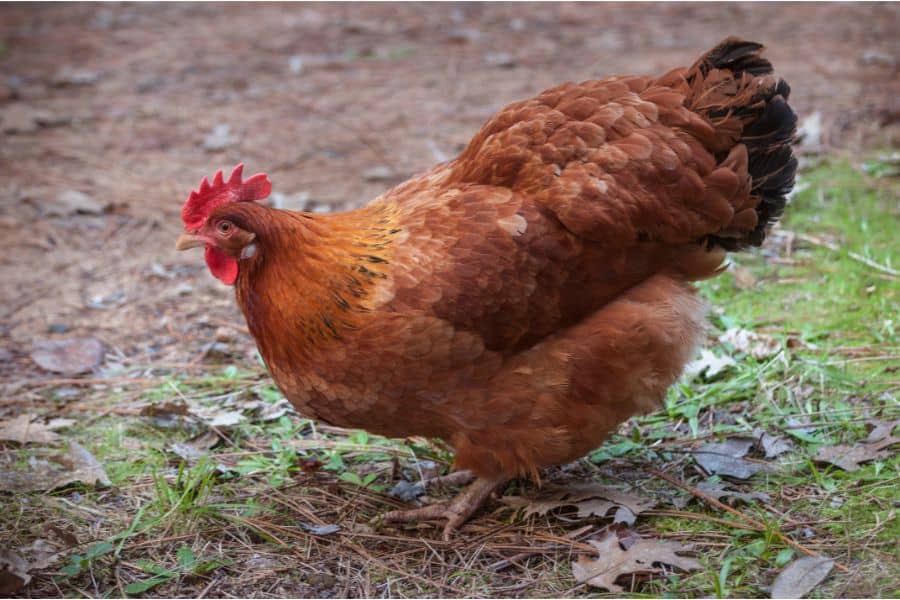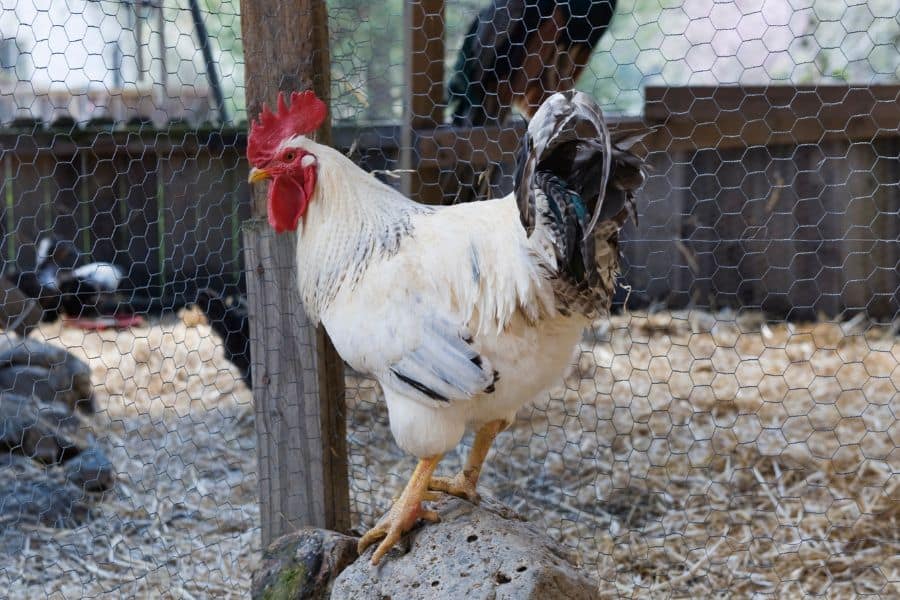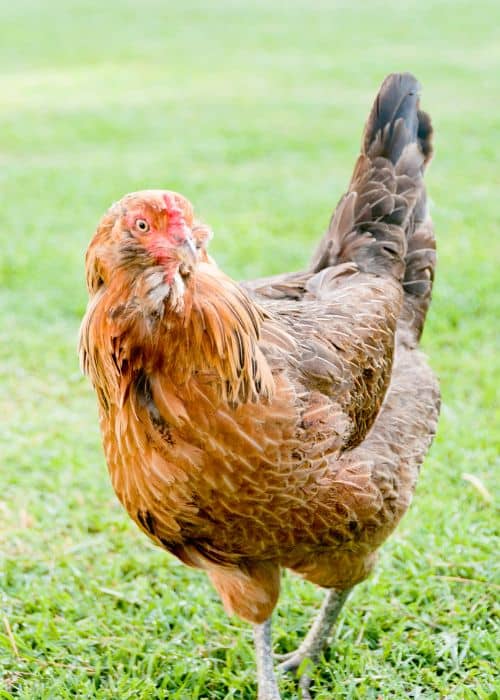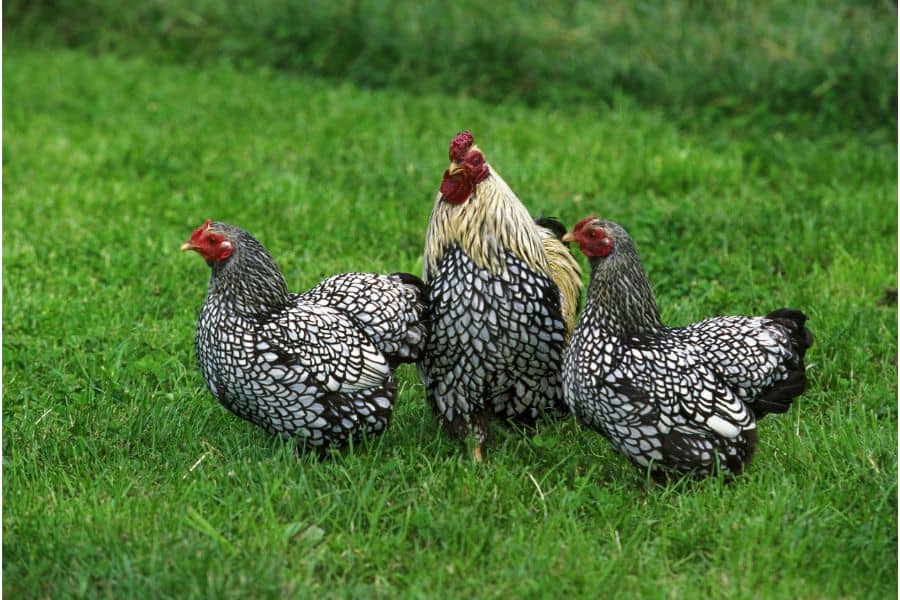No country is associated with chicken in the world like the United States of America. As it is the world’s biggest poultry meat producer, this should not come as a surprise.
America’s association with chickens runs deeper than its current production and consumption of these birds’ delicious meat and eggs. The country has played an important role in the developments we see in chicken farming all over the world.
Many of the chicken breeds we see today were either developed in the USA or bred from American chicken breeds. This has given rise to breeds that have qualities such as:
- Fast growth
- High rate of egg production
- Heavier bodies
- Cold hardiness
The main reason why many of these chicken breeds were developed in America was the high demand for chicken eggs and meat there. These American breeds are now available in many countries worldwide, enabling others to enjoy their benefits as well.
Getting a true-breed American chicken can ensure that you get a steady supply of meat and eggs and give you the means to raise chicks with predictable qualities.
We dive deep into the different American chickens available today and examine their origins and qualities.
Top 10 American Chicken Breeds
Dominique Chicken
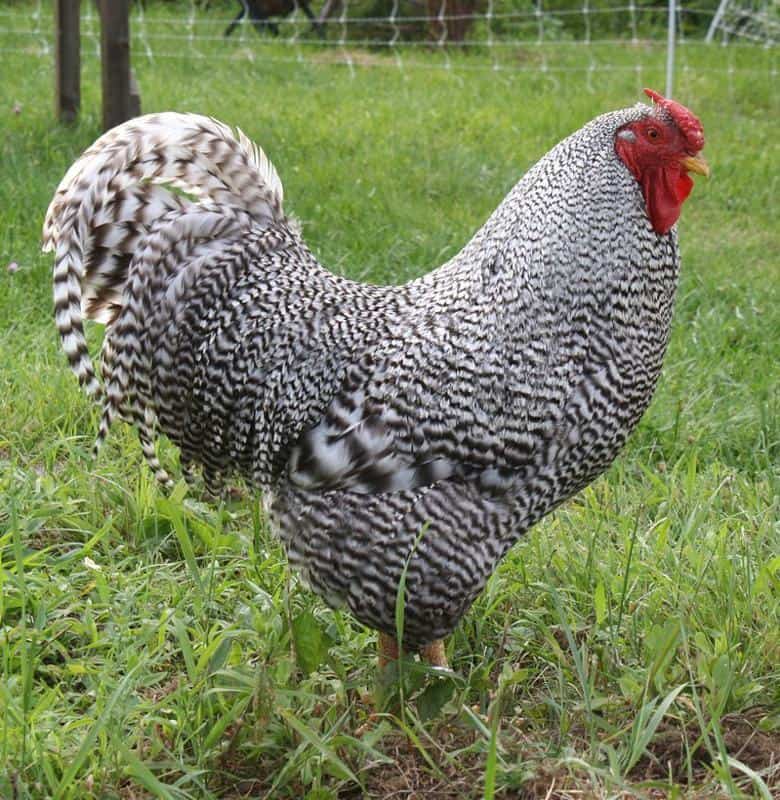
| Names | Dominique, Pilgrim Fowl, Old Grey Hen, Blue Spotted Hen, Dominico |
| Primary Purpose | Brown Eggs |
| Egg Production | 200 |
| Weight | Roosters: 7 lbs.
Hens: 5 lbs. |
| Plumage Varieties | Barred (light and dark) |
| Climate | Cold-Hardy |
| Special Fact | Oldest American chicken breed |
This chicken is considered the oldest chicken breed of American origin. The Dominique is said to be the offspring of the chickens brought by American colonists from England.
By the 1750s, the Dominique chicken was already a famous bird in America.
These chickens can either have a rose comb or a single comb and are medium-sized with the males typically weighing 7 pounds at maturity. The plumage of this chicken is tightly held and features alternating light and dark barring.
The Dominique chicken breed goes by several other names including Pilgrim Fowl, Old Grey Hen, and Blue Spotted Hen. They featured in the 1849 Boston poultry show, the first to be held in the country.
The Dominique chicken can be used for both eggs and meat, but its brown eggs are said to be the main reason most farmers keep them. The hens lay around 200 eggs per year.
Plymouth Rock Chicken
| Names | Plymouth Rock |
| Primary Purpose | Brown eggs and meat |
| Egg Production | 200 |
| Weight | Roosters: 9.5 lbs.
Hens: 7.5 lbs. |
| Plumage Varieties | Barred (light and dark), buff, partridge, blue, white, Columbian, and silver penciled. |
| Climate | Cold-Hardy |
| Special Fact | Most kept chicken in the United States before WWII |
The Plymouth Rock chicken was named after the rock found at the Pilgrims’ landing site, but it certainly wasn’t the chicken kept by the Pilgrims. The first public appearance of this chicken was in 1849.
The Dominique is said to be one of the chicken breeds from which the Plymouth Rock was created. The original Plymouth Rock chicken sports a barred plumage similar to the Dominque’s and a single comb.
The Plymouth Rock was the most popular chicken in the United States before the Second World War. Farmers favored this breed because of its temperament, hardiness, broodiness, and suitability as a dual-purpose bird.
The Plymouth Rock can produce around 200 eggs in a single year, and it is said to be quite delicious when slaughtered. The eggs from this chicken breed are large and brown.
Plymouth Rock hens are said to lay eggs into their 10th year although the rate of production gradually goes down after the first years. These hens also make excellent mothers to their chicks.
Rhode Island Red
| Names | Rhode Island Red |
| Primary Purpose | Eggs and meat |
| Egg Production | 200 – 300 |
| Weight | Roosters: 8 lbs.
Hens: 6 lbs. |
| Plumage Varieties | Red with black tails |
| Climate | Cold-Hardy |
| Special Fact | Considered most successful dual-purpose breed |
Although it was developed later than the Dominique and the Plymouth Rock, the Rhode Island Red has been a greater success than the first two. This chicken is, perhaps, the best-known breed today and its story started in the 1880s in Rhode Island and Massachusetts.
Right from the start, the Rhode Island Red was expected to excel as both a layer and a meat bird. As far as laying is concerned, some believe no other dual-purpose breed is as productive as the Rhode Island Red.
The plumage of the Rhode Island Red is mainly red, but it also has a black tail with a green sheen. The red combs can be of the single or rose variety.
Although these birds were intended to be a dual-purpose breed, there are modern variants that were bred with better egg production in mind. Unlike the traditional Rhode Island Reds, these new variants have small bodies and light colors, and the hens won’t be as broody.
Usually weighing more than 8 pounds, it is not uncommon to find aggressive Rhode Island Red roosters. This breed can survive tough conditions while still laying regularly.
Delaware
| Names | Delaware, Indian River |
| Primary Purpose | Large eggs and meat |
| Egg Production | 200 |
| Weight | Roosters: 7.5 lbs.
Hens: 5.5 lbs. |
| Plumage Varieties | White body with black back barring at the tail, wings, and hackles |
| Climate | Cold and heat hardy |
| Special Fact | Was once the most important broiler in the US East Coast. |
The creation of the Delaware chicken breed was something of an accident. The first of these chickens were sports that arose when New Hampshire hens and Plymouth Rock roosters were being crossed to produce chickens that would serve as good broilers.
The mostly white feathering of these chickens made them the most sought-after meat birds in the Delmarva Peninsula. The white feathers resulted in better-looking carcasses after slaughter.
Unfortunately for this chicken breed, its importance to the meat industry did not last as solid white chickens from other breeds were introduced in the 1950s. So quick was the decline in this breed’s popularity that it is currently considered an endangered breed.
The Delaware chicken only comes in one color type. Apart from some black barring that shows up in the wings, tails, and hackle, the rest of the chicken’s body is white.
Despite its rarity, the Delaware chicken is a surprisingly good dual-purpose bird that can provide your table with around 200 eggs every year. Many new farmers today are taking an interest in this chicken breed.
New Hampshire Red
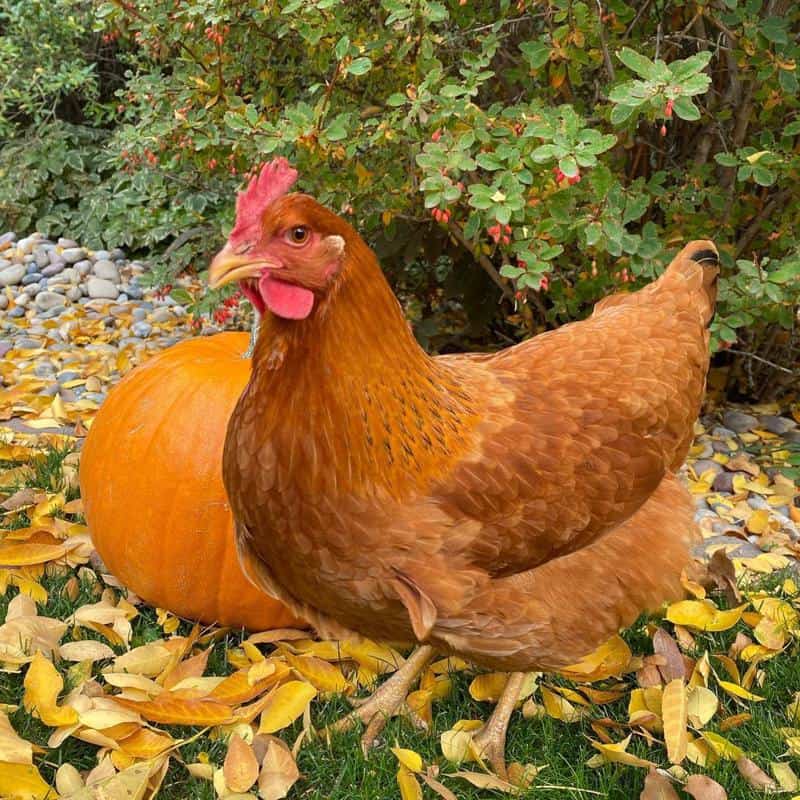
| Names | New Hampshire, New Hampshire Red |
| Primary Purpose | Meat and eggs |
| Egg Production | 220 |
| Weight | Roosters: 8.5 lbs.
Hens: 6.5 lbs. |
| Plumage Varieties | Red, White, Blue-tailed red |
| Climate | Cold and Warm with appropriate housing |
| Special Fact | Was used in the development of the Delaware chicken. |
The New Hampshire chicken is a 20th-century chicken that was the result of selectively breeding Rhode Island Reds that matured and feathered faster than others.
Although no other breed was involved, the method used to select chickens was so particular that it led to an entirely different breed from the Rhode Island Red. As the name suggests, this breed was partially developed in the state of New Hampshire.
The New Hampshire chicken was important to the establishment of the broiler industry in the United States after World War II. It has since received recognition by being made the official state poultry of the state that shares its name.
Although they are typically associated with the meat industry, New Hampshire chickens are good layers and can give you as many as 220 large eggs in a year. At maturity, the males weigh around 8.5 pounds which is one reason why they make good broilers.
The plumage of these chickens is close to chestnut in color but may have some yellow bits. Just like Rhode Island Reds, the roosters have black tail feathers.
Although they are considered good for beginner chicken farmers, they have been known to get aggressive, especially with less assertive breeds.
Jersey Giant Chicken
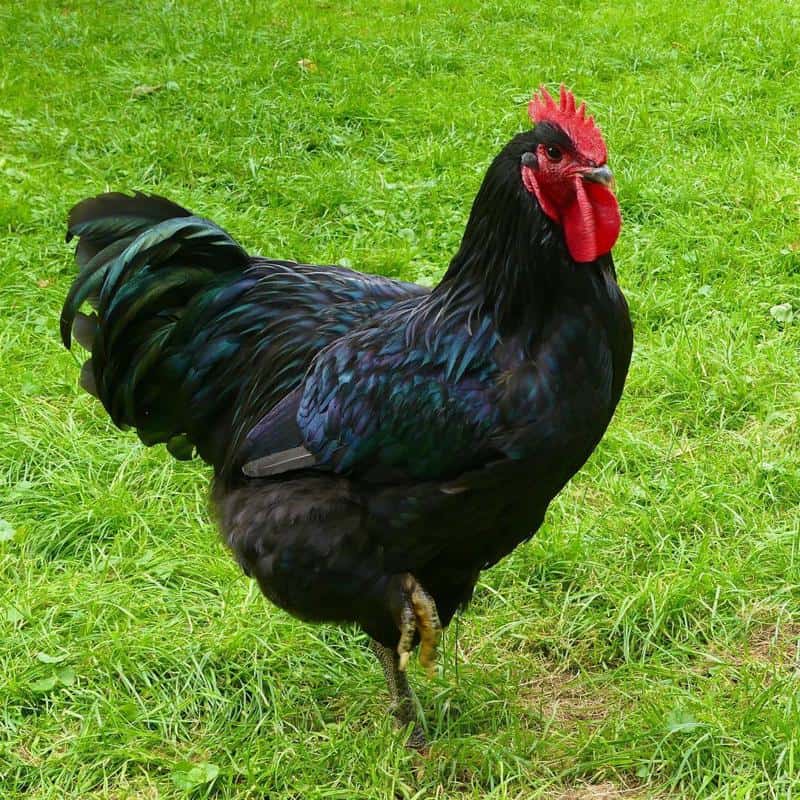
| Names | Jersey Giant, Black Giant |
| Primary Purpose | Meat |
| Egg Production | 150 – 200 |
| Weight | Roosters: 15 lbs.
Hens: 11 lbs. |
| Plumage Varieties | Black, White, Blue |
| Climate | Cold hardy, not heat tolerant |
| Special Fact | Like to cuddle |
Developed in the 1870s, the most important feature of this chicken is in its name. Jersey Giants frequently top the scales at 15 pounds and were developed with the intention of replacing turkeys on American tables.
Jersey Giants have three common color variants, black, white, and blue. The black variants will have a green sheen on their feathers while the white variants have olive green shanks.
The black variant of the Jersey Giant is the heaviest, but any variety of this chicken will provide more meat than most other chickens. Although they’re usually kept for their meat, the hens can also produce 150 to 200 eggs in a single year.
These chickens handle cold weather very well, but they don’t do as well in hot weather. This breed is also large enough to fight certain predators but is also known for not being aggressive even against other chicken breeds.
Java Chicken
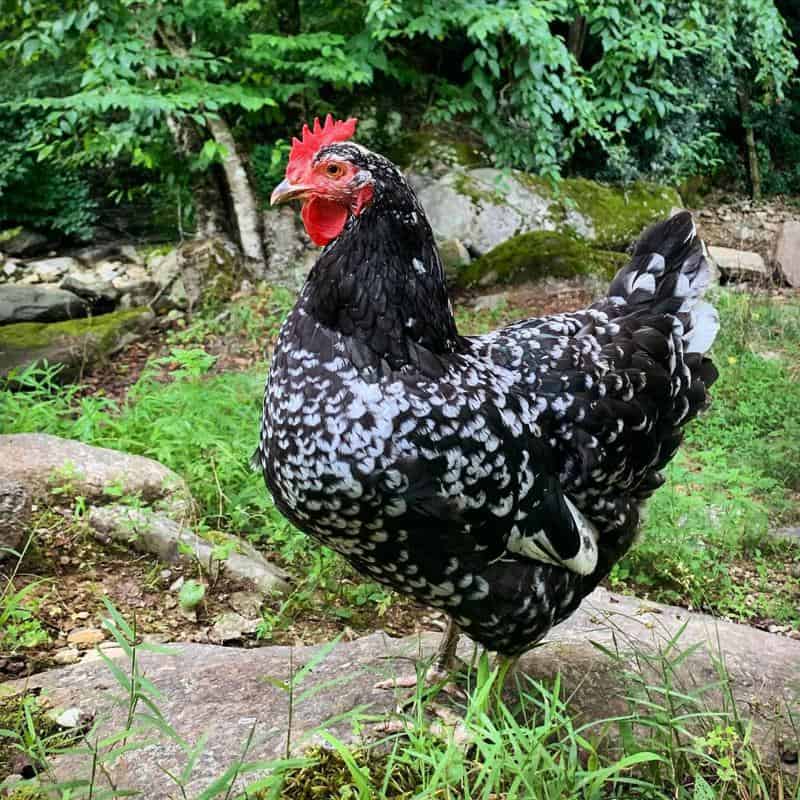
| Names | Java |
| Primary Purpose | Eggs and Meat |
| Egg Production | 150 – 180 |
| Weight | Roosters: 9.5 lbs.
Hens: 7.5 lbs. |
| Plumage Varieties | Black, Mottled, White |
| Climate | Heat and cold tolerant |
| Special Fact | The extinct auburn variant helped developed the Rhode Island Red. |
It may sound like a cup of exotic coffee, but Java also happens to be the name of a chicken breed that was developed in the United States. These chickens were developed from a variety of Asian chickens whose identities are yet to be established.
Java chickens are the second oldest American chicken breed and were first mentioned in written history in 1835. During the 1800s, Javas gained recognition as meat birds, becoming especially popular in the latter half of that century.
Although Java chickens were almost pushed to extinction in the late 20th century, this breed was essential in the development of other well-known breeds. Plymouth Rock, Jersey Giant, and Rhode Island Red chickens all have Java chicken ancestry.
The black, white, and mottled varieties of the Java chicken are the only ones still around today. The auburn variant went extinct in the latter half of the 1800s.
The black Java has plumage that is black with a highly regarded green sheen. The mottled variant’s feathers have a black base and white marks on the feather tips.
Java chickens make good backyard flocks because they love to forage for their food. They develop slowly and thus take longer than other breeds to attain market weight.
Ameraucana Chicken
| Names | Ameraucana |
| Primary Purpose | Blue eggs |
| Egg Production | 150 – 200 |
| Weight | Roosters: 6.5 lbs.
Hens: 5.5 lbs. |
| Plumage Varieties | White, silver, black, wheaten, brown-red, blue, blue wheaten, buff. |
| Climate | Cold-Hardy |
| Special Fact | They have the blue egg gene. |
Although it’s a newer breed compared to the others on this list, it is impossible to leave out the Ameraucana when talking about American chickens. These birds have only been around since the 1970s and were recognized as a breed in 1984.
What makes the Ameraucana’s special among American chickens is their ability to produce blue eggs. This is because this breed was derived from the Chilean Araucana which also produces blue eggs.
During the development of this chicken breed, measures were taken to eliminate the lethal alleles that are present in Araucanas. The Ameraucana comes in eight color varieties including blue, brown, and white.
Ameraucanas are relatively small birds with the roosters reaching around 6.5 pounds. Despite their size, some hens can produce as many as 200 eggs each year.
Buckeye
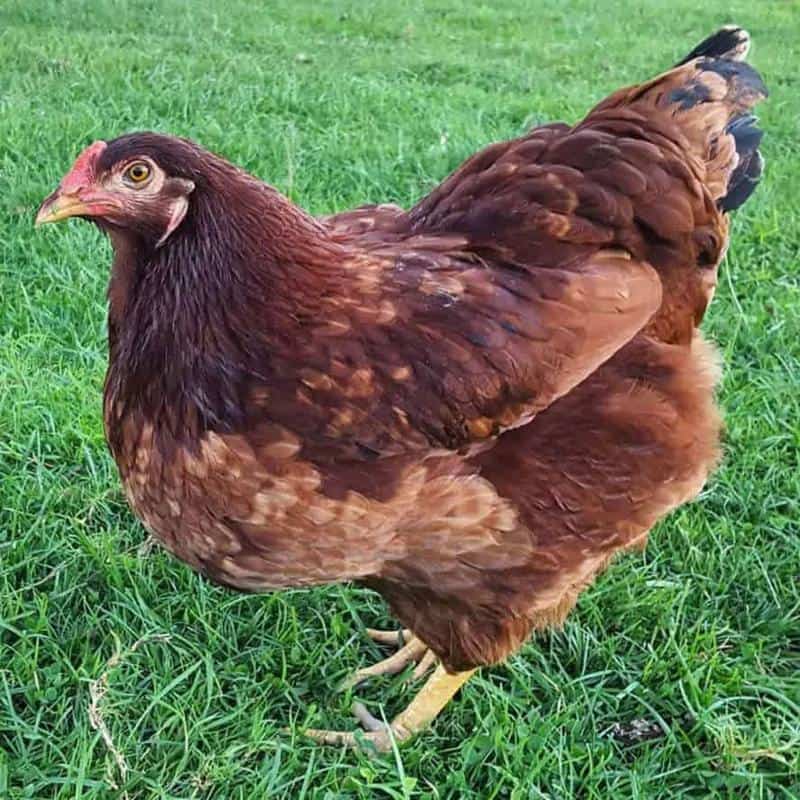
| Names | Buckeye, Pea Combed Rhode Island Red (defunct) |
| Primary Purpose | Meat and Egg Production |
| Egg Production | 175 – 240 |
| Weight | Roosters: 9 lbs.
Hens: 6.5 lbs. |
| Plumage Varieties | Mahogany red |
| Climate | Cold Hardy |
| Special Fact | Highly active and will even pursue mice |
The Buckeye chicken breed is a breed that was developed in 1896. It is famously known as the only chicken breed of American origin that was developed by a woman.
The egg-laying productivity of many chickens suffered during winter and the midwestern winters were quite bitter. Nettie Metcalf developed the Buckeye to remain productive during such periods.
Metcalf initially called her chickens Pea Combed Rhode Island Reds but she later changed the breed’s name to Buckeye.
As a homestead chicken, the Buckeye is quite appealing because it’s not just productive but also hardy and a good forager around the farm. Unfortunately, the shift to large-scale chicken farming almost drove the breed to extinction since it wasn’t popular with the producers.
Buckeye chickens get their name because their color is similar to that of Buckeye seeds. Their bodies are a deep mahogany, and their tails are black.
Wyandotte
| Names | Wyandotte, American Sebright (defunct), Sebright Cochin (defunct) |
| Primary Purpose | Meat and Egg Production |
| Egg Production/Year | >200 |
| Weight | Roosters: 9 lbs.
Hens: 7 lbs. |
| Plumage Varieties | Silver laced, golden laced, white, buff, black, blue, Columbian, partridge, and silver penciled. |
| Climate | Cold Hardy |
| Special Fact | Was named after the Wyandot people. |
The Wyandotte has distinguished itself as a show bird and it certainly deserves to be one. The lacing on the feathers of this chicken makes it a marvelous bird to behold.
Wyandottes were named after North America’s Wyandot people and was developed to provide yellow-skinned meat and brown eggs. Although it was good at these purposes, it became particularly popular as a show bird and now has nine color varieties.
The original Wyandotte chicken was developed sometime in the 1870s by a team of four. This was the silver-laced variety, and it was added to the Standard of Perfection in 1883.
Wyandottes are hefty birds, and the roosters will weigh as much as 9 pounds. They are cold hardy and grow relatively fast making it easy for farmers to keep them as meat birds.
Wyandottes also make decent layers for a dual-purpose breed. Farmers report getting more than 200 eggs from their hens every year and the same hens weigh as much as 7 pounds at maturity.
Also Read:
Centuries of Worthy Breeds
There are few things that are as American as chicken. If you’re looking to get into chicken farming, you must consider some of these American breeds.
American chicken breeds were developed to help farmers get the best of all words. These chickens can:
- Withstand cold weather.
- Lay many eggs.
- Grow faster than other breeds.
Despite these qualities, many of these chickens are also facing extinction because they are better suited for backyards and small farms, not commercial production.
Luckily, the popularity of many classic American breeds has been on the rise recently. These chickens typically love an active lifestyle, the kind they can’t get in a factory setting but one that makes them a great choice for your backyard.
